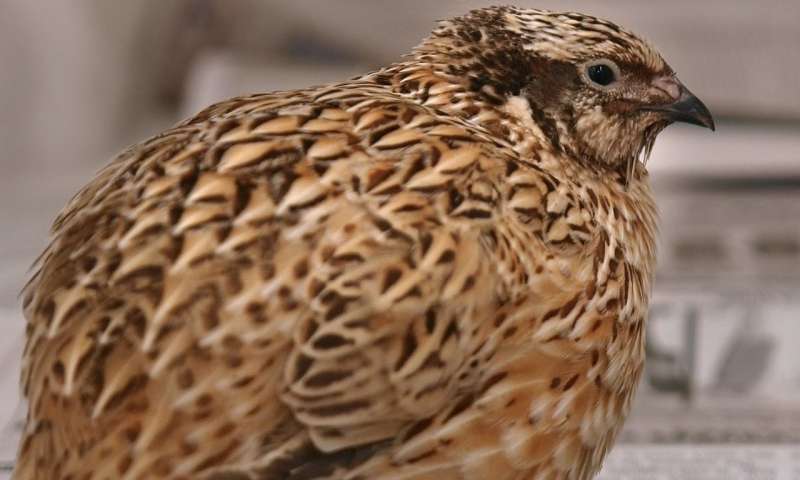September 26, 2018 report
What's behind the color and pattern of bird feathers?

While it may be true, as the old adage goes, that 'birds of a feather flock together,' what is less certain is how the feathers on those birds come to have their distinct patterns and colorations. Current data suggest that patterns of stripes and spots on animals' fur or feathers are formed through an open-ended or stochastic process during the embryonic formation of skin, at which time a dynamic—such as Turing's reaction-diffusion—is at play. On the other hand, owing to their specific orientation and periodictity, and the highly reproducible nature of these patterns within species, it is thought that other factors may also be at work in the development of patterning and coloration.
To better understand the phenomenon of feather patterning and coloration, a group of French researchers led by Nicolas Haupaix undertook a study of galliform birds. In looking at an initial group of 10 species, the researchers sought to deterimine whether or not early developmental landmarks play a role in establishing spatial reference for periodic patterns in feathering. They identifed two main types of feathers among these species: entirely black (eumelanic) and yellow (a black base and tip, with a central yellow [pheomelanic] band in between). Henceforth, they were able to establish a common stripe sequence emanating from the dorsal midline: a central black stripe, sometimes containing a few yellow feathers, flanked on either side by a yellow stripe, each of which was bordered by another black stripe, which in turn was borderd by another yellow stripe.
From this, the researchers observed that an increase in dorsum size correlated with an increase in stripes, suggesting that color pattern variation is not necessarily the result of scaling. In fact, in measuring absolute distances between groups of stripes, they were able to infer that stripe position is determined early, before the skin expands. The researchers also found, by plotting feather tracts in relation to stripe boundaries, "that color boundaries are highly reproducible within species," but that these boundaries vary between species in relation to stripe width and stripe shape, suggesting that the variations in width and shape are due to local effects present during feather tract formation.
Working from these findings, Haupaix and colleagues examined pigment production and feather tract formation during embryogenesis in five galliform species, each representative of distinctive variations in the width and shape of stripes and the organization of the dorsal tract. They found that pigment production begins a few days before hatching, when all dorsal tract feather follicles are visible. The black central feathers are colored first with eumelanin, the default tissue pigment, which is then succeeded by a "pulse" of pheomelanin. This forms the banded yellow pattern of the lateral feathers. This phase is then succeeded by a return to eumelanin production for the farthest lateral feathers and transient production of pheomelan, in the case of birds with a central yellow stripe.
The research group then tested whether yellow pulses occur at certain stages of feather tract differentiation by staining developing follicles with beta-catenin. Their results indicated that these pulses were not related to any mechanism taking place during tract formation, so they next examined whether the pulses were triggered by feather growth. Finding no correlation between feather growth and yellow pulses, the investigators then theorized that the yellow pulses are governed by prepatterns established before skin differentiation, and governed by the signalling peptide Agouti. They ultimately found that agouti-expressing bands are present in the dermis prior to follicle formation, and that these bands foreshadow the position of the yellow stripes. They confirmed their findings by performing a double in situ hybridzation for agouti and beta-cateninin the species Coturnix japonica.
To further demonstrate the relationship between agouti and the yellow pulse, the researchers looked at the striped phenotype in mutant strains of C. japonica. Examining recessive black quails (RB-/-) and fawn quails (FA-/-), they compared differences in phenotypes with genetic data related to the expression of agouti and the duration of the yellow pulse. They found that the agouti gene directly controls stripe width in a dose-dependent manner via the duration of the yellow pulse. On these findings they conclude: "This raises the appealing possibility that striped pattern evolution is governed by differential regulation of agouti expression levels."
Finally, in a grafting experiment designed to determine whether the somitic mesoderm controls agouti expression and stripe position, the researchers transplanted somites and neural tubes from the right side of C. japonica onto the right side of P. colchicus. They used immunohistochemistry staining with QCPN to track cell growth and development from the grafted section, and track expression of Trp1, a marker for black pigment generating melanocytes. The result of their operation was a chimera whose right side showed the phenotypic characteristics of the C. japonica donor, thus demonstrating that the localized expression of agouti and the associated pigments are governed autonomously by the somitic mesoderm.
The authors of this study thusly conclude that the striped pattern in birds is governed by a two-part mechanism. First, the somite determines the location and positioning of agouti-expressing bands in the dermis through the establishment of a prepattern. Then, the prepattern is further elaborated on with respect to the differing levels of expressed agouti, which in turn determine the width of each stripe. "These results," the reasearchers write, "raise the possibility that most natural patterns, including periodic designs, rely on (and are constrained by) a stepwise organization of space that combines late local events producing periodicity and early positional sources ensuring reproducibility, which is the key to fitness and proper directionality (in this case, longitudinal stripes depend on information from axial structures)."
More information: Haupaix et al. The periodic coloration in birds forms through a prepattern of somite origin. Science 21 Sep 2018: Vol. 361, Issue 6408, eaar4777. DOI: 10.1126/science.aar4777
Journal information: Science
© 2018 Phys.org




















